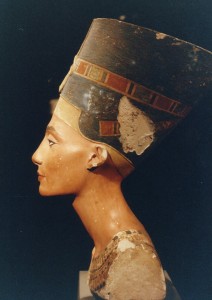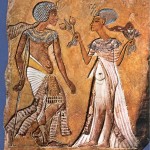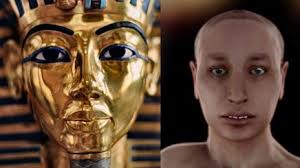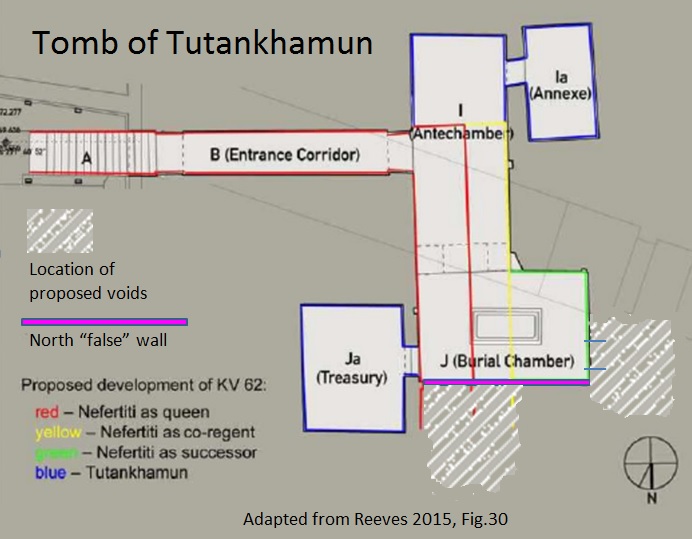 I don’t often let myself get enthused about media-hyped archaeological stories before the evidence is in. This time, I can’t help myself. The claim headlined over the last few months, that Tutankhamun’s tomb may hide some untouched secret chambers, holds out the promise of once-in-a-lifetime excitedness, a discovery on a level with the first opening of the tomb itself in 1922. If, of course, there is anything to it.
I don’t often let myself get enthused about media-hyped archaeological stories before the evidence is in. This time, I can’t help myself. The claim headlined over the last few months, that Tutankhamun’s tomb may hide some untouched secret chambers, holds out the promise of once-in-a-lifetime excitedness, a discovery on a level with the first opening of the tomb itself in 1922. If, of course, there is anything to it.
Please, please, please, please, please, please, please.
Tut’s tomb was always considered remarkable for being so small—other royal tombs were elaborate affairs cut deep into bedrock, with long corridors, staircases, shafts, and several chambers on multiple levels. The explanation for Tut’s little bachelor pad was that a convenient non-royal noble tomb, commandeered when the young pharaoh died suddenly, was enlarged enough to take a decent array of royal pretties, which in turn were scraped together from what the treasury had on hand. Tut’s tomb was thus the hand-me-down ad-hoc burial of a minor and probably quite embarrassing pharaoh, notable because it was only slightly robbed in antiquity, and then forgotten.
The new hypothesis looks at Tut’s bedsit from the other direction: not as a small tomb hastily enlarged, but as the uppermost antechambers of a full-size royal tomb, hastily adapted to take a second burial. And the primary burial, deeper in the rock? According to Egyptologist Nicholas Reeves, the real owner of the tomb is the mysterious pharaoh Ankhkheperure Smenkhkare, who in turn is none other than the iconic beauty Nefertiti, widow and successor to the heretic pharaoh Akhenaten.
Please, please, please, please, please, please, please.
It is not the prospect of more fabulous New Kingdom golden treasure that is exciting, though that would, of course, be quite nice. Who knows what wonders would emerge from the unbreached burial of an Egyptian pharaoh? But the really thrilling prospect is the light that would be shed on the shadowy last years of the Amarna period—a history that the post-Amarna Egyptians themselves tried to obliterate, and Egyptologists have obsessively debated for generations.
I’ve written about Akhenaten and Amarna before. The whole period is problematic,  but the mystery gets ramped up in the six or so years after the death of Akhenaten, and before Tutankhamun’s accession to the throne. There is good evidence that Akhenaten took a female co-regent—Neferneferuaten—in the last years of his reign, that the co-regent took power after his death, and that at least one other named pharaoh—Smenkhkare—briefly preceded Tut. But who are these people? The list of candidates includes Nefertiti, several of her daughters with Akhenaten, some otherwise invisible male royals, and even a Hittite prince. And there are questions that cannot be answered with the available data. Which of them was the female co-regent? Was Smenkhkare a man or a woman? Were Nefertiti, Neferneferuaten, and Smenkhkare all one person, or two or three different people? Why are no burials known for Nefertiti and Smenkhkare? Who was the queen who wrote that dramatic letter to the Hittite king? Who instigated the move back to Thebes? In fact, much of what seemed to be established about the Amarna period when I was a student has since returned to the debating table. An untouched late Amarna royal tomb could go a very long way towards solving those mysteries.
but the mystery gets ramped up in the six or so years after the death of Akhenaten, and before Tutankhamun’s accession to the throne. There is good evidence that Akhenaten took a female co-regent—Neferneferuaten—in the last years of his reign, that the co-regent took power after his death, and that at least one other named pharaoh—Smenkhkare—briefly preceded Tut. But who are these people? The list of candidates includes Nefertiti, several of her daughters with Akhenaten, some otherwise invisible male royals, and even a Hittite prince. And there are questions that cannot be answered with the available data. Which of them was the female co-regent? Was Smenkhkare a man or a woman? Were Nefertiti, Neferneferuaten, and Smenkhkare all one person, or two or three different people? Why are no burials known for Nefertiti and Smenkhkare? Who was the queen who wrote that dramatic letter to the Hittite king? Who instigated the move back to Thebes? In fact, much of what seemed to be established about the Amarna period when I was a student has since returned to the debating table. An untouched late Amarna royal tomb could go a very long way towards solving those mysteries.
Please, please, please, please, please, please, please.
Of course, it is perfectly possible that there is nothing behind the walls of Tutankhamun’s burial chamber; it is possible that the scan results are false positives; or that voids exist behind the walls, but are no more than rough-cut dead ends full of boring old construction debris. I hate the thought, but it’s possible. However, Reeves lays out other lines of evidence in the paper cited above, and they are both hopeful and compelling.
He argues that Nefertiti ruled Egypt, first as co-regent, then as pharaoh in her own right—a kind of Karen Zerby to Akhenaten’s Mo Berg. Her tomb was begun in the pattern common for royal wives, and became more ambitious as her status changed, perhaps developing into a corridor tomb of the sort reserved for kings. (See the picture.) Then she died, and was duly buried in it. When her successor Tut died suddenly about a decade later, the upper part of the tomb was opened as far as the false wall that generally sealed off access to farther chambers in such tombs; and the antechamber and upper corridor were rather clumsily adapted for a secondary burial. The false wall—the north wall of Tutankhamun’s burial chamber—would thus be the entrance to Nefertiti’s portion of the tomb. Significantly, that north wall was painted at a different time from the others, using a uniquely Amarna-period design grid that that fell out of use during Tutankhamun’s reign. This is not a slam-dunk—nothing in Reeves’s paper is a slam-dunk on its own—but his overall scenario is plausible enough to warrant some enthusiasm.
Alas, even if the new round of tests does support the shared-tomb theory, we will still be a long way from solving Amarna’s mysteries. Years, probably—but the results will be worth waiting for. And oh, the irony! The false walls in all those other tombs never once fooled the tomb robbers of ancient times—but this one, if that is what Tut’s north wall is, has had the archaeologists fooled for nearly a century.


